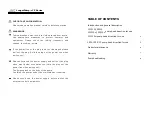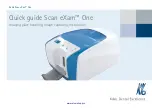
4 Repairs
4.1
Check of transistors
Check the transistors before exchanging, in order to save unnecessary costs.
The transistors can be checked in the inserted condition:
B C E
Check of the bipolar transistors (generators without ICs):
1) Diode behaviour of the paths B-E, B-C and E-C: in forward direction
approx. 300 … 500 mV voltage drop. In reverse direction no check is possible
due to the circuitry outside the transistor.
In some generators the inverse diode (E-C) is situated at the board and can
not be checked at the desoldered transistor.
Check of IGBTs
(
generators
with ICs)
:
G C E
1) Diode behaviour of the path E-C: in forward direction
approx. 300 … 500 mV voltage drop.
2) The path G-E is “high impedance”, but to parallel circuitry it
takes some seconds to obtain a voltage > 1 V.
The voltage drop indicated depends on the instrument and is
different for the two IGBTs due to different circuitry.
4. 2 Exchange of transistors
4. 2. 1 Transistors in insulated case (Isowatt 218)
The transistors (for example BUV 48 AFI/IV48A (Isowatt 218)) are mounted on the base plate.
They can be exchanged as follows:
-
Loosen the self locking nut M3 on the transistor.
-
Cut off the transistor connections just below the transistor using side cutting pliers.
-
The transistor is attached to the base plate by means of heat conducting paste, remove defective
transistor using a knife blade or similar.
-
Desolder the transistor connections.
-
Tighten the new transistor with self locking nut.
-
Solder the connections to PCB.
6
self locking nut and disc
base plate
heat conducting paste
disc 3,2
hexagon socket head cap screw
DIN 912 M 3 × 12
transistor Isowatt 218 BUV 48 AFI/I V 48 A







































